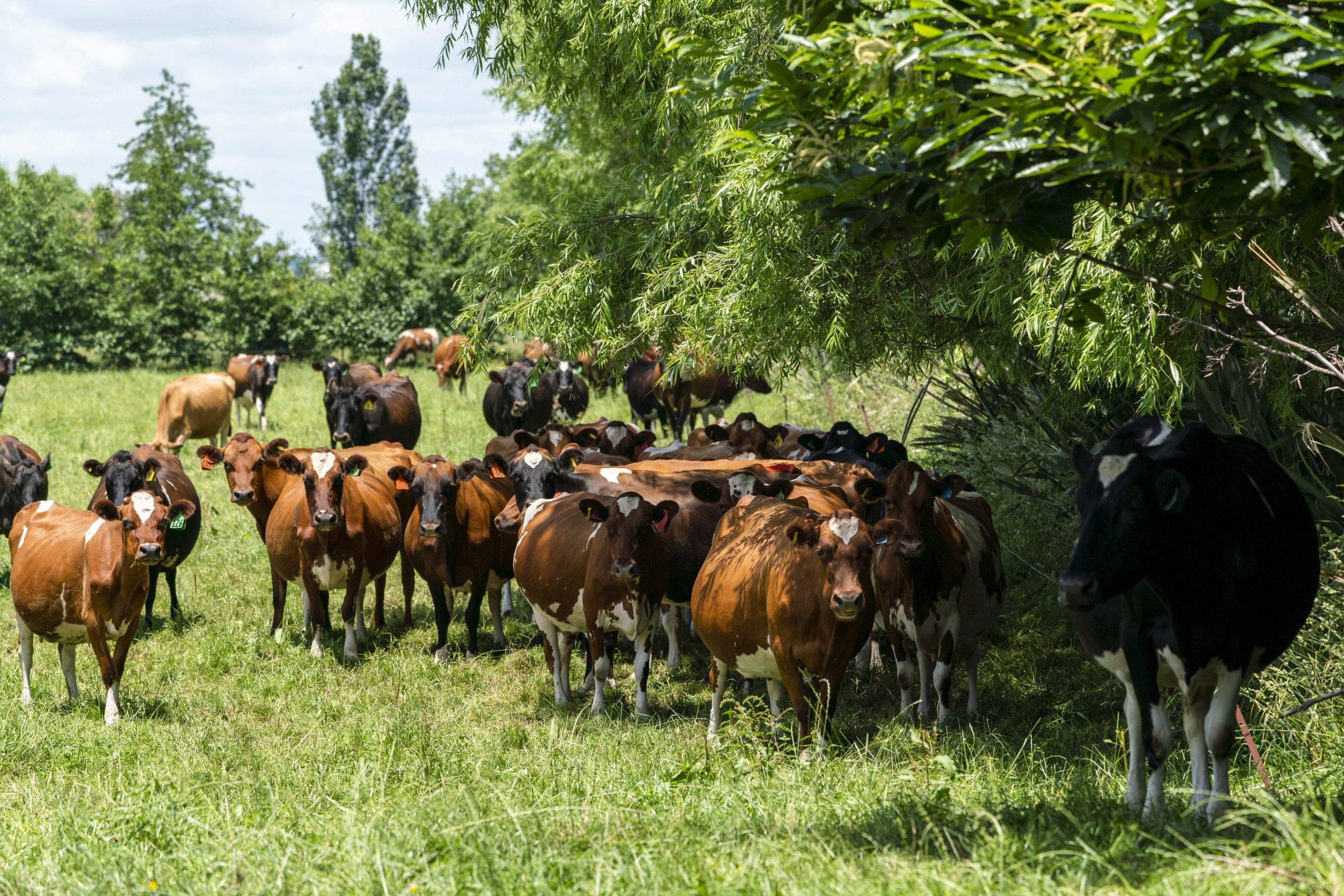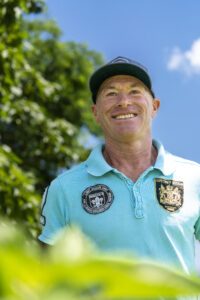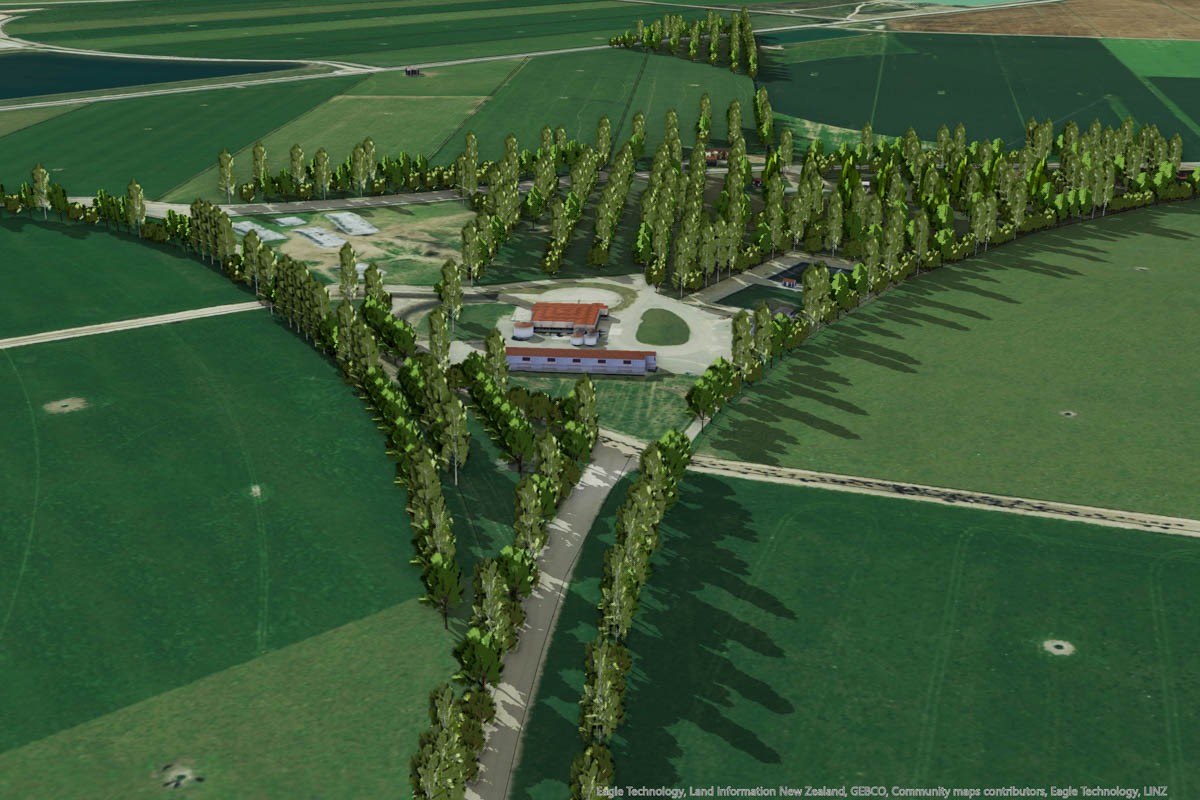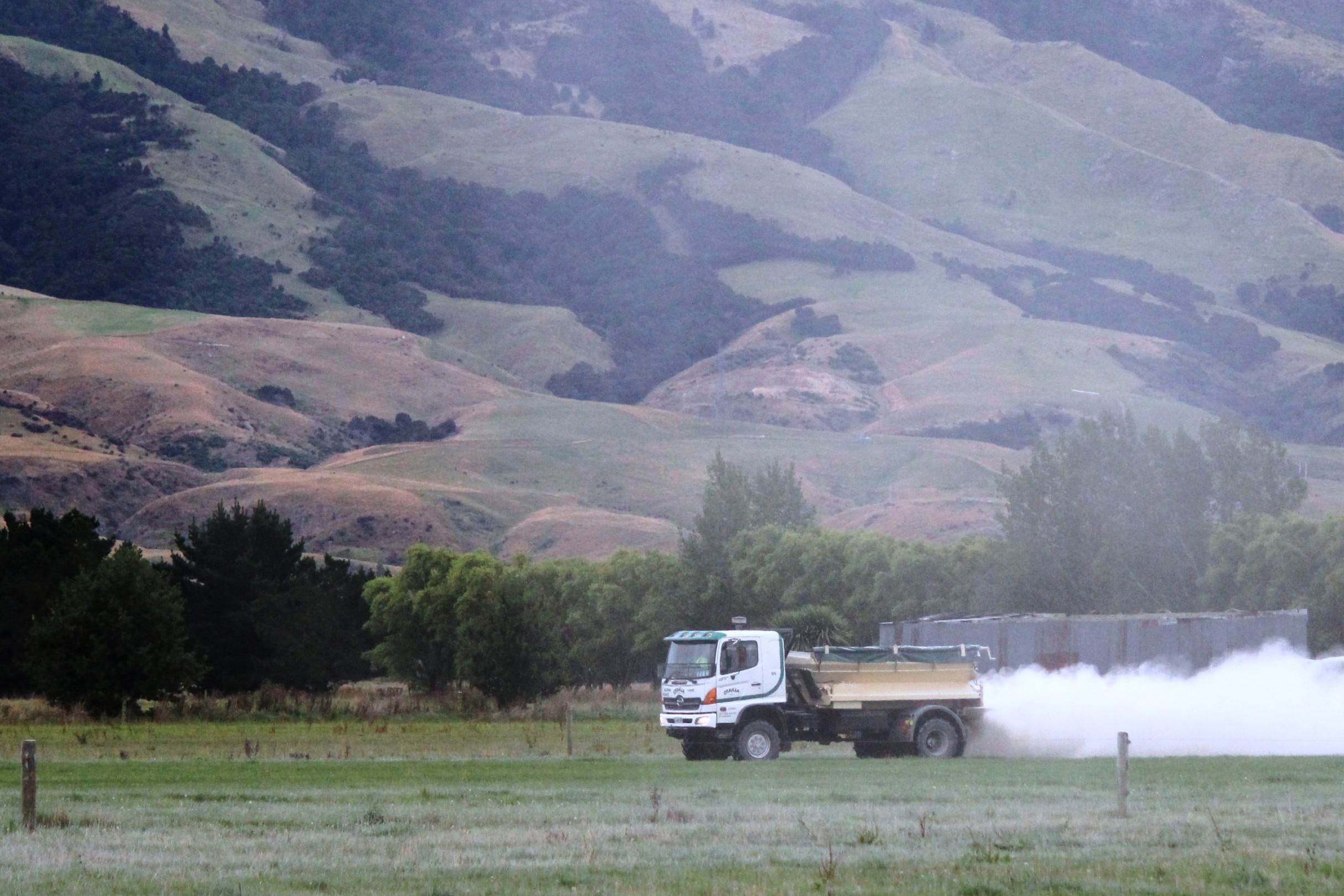Multi-functioning trees
Grazing principles include vertical grazing on Gavin Fisher’s organic dairy farm at Te Aroha. Gavin is farmer ambassador for the Organic Dairy Hub Co-op NZ Ltd. He talked to Sheryl Haitana about how he’s creating a future-proof farming business.

Any tree planted on Gavin Fisher’s farm during the past 41 years has had to tick as many boxes as possible: shade, shelter, habitat, nutrient cycling, produce, dietary and health benefits for the cows to name just a few.
Gavin associates all the trees, shrubs and plants grown on the milking platform as part of his grazing rotation, utilising every vertical inch of growth as well.
“Our grazing is tiered, we have vertical and canopy grazing. A cow can reach at least 1.5m high.”

Every paddock fence line is planted out, with the tree trunks protected behind fencing and it’s clearly visible where the trees have been grazed.
“If you fold that out, it’s a huge grazable area that you wouldn’t have ever had. So it’s utilisation of the land.”
Not surprisingly, it’s brought a whole lot of bird life into the property and they’ve got native birds that have never been seen on the farm before.
Gavin has a vast array of plantings across the farm, from hedges of feijoas, olives and rosemary to nut trees, fruit trees and native trees.
There is a mix of deciduous and evergreen trees and a lot of shrubs which are cow height to protect the cows in winter from southerly winds.
The species selected are also chosen for what is good for the cows’ diet, such as flax which the cows love grazing on and helps to prevent worm burden.
“When I look at what I’m planting, in the summer you want shade and filtered light. In the winter you want warmth.”
The bigger trees lose their leaves in autumn, which is part of the nutrient recycling system, and it lets light in for the winter months to avoid the farm becoming too cold and damp.
Gavin has planted using angles, so in summer there is only sunlight penetrating half the paddock at a time.
This helps with giving cows ample shade while also keeping moisture on the ground for longer to help with grass growth during the hotter months.
A lot of the trees and plant roots go down many metres further than the shallow rooting grasses, so they are able to pull up more nutrients. It’s adding a diversity of minerals and nutrients to the cows’ diets that the animals wouldn’t otherwise be getting, Gavin says.
“At the same time it’s creating the ecology and habitat I need in my system.
“I try to nurture and foster ecologies and just farm them in a sustainable way. I think that’s a really good food production system.”
The cow is a bovine biological harvester and giving them access to a larger variety of food groups which lets the cows be selective of what they want and need to browse on.
The paddocks contain multiple grass and herb species mixtures. The grass growth curve is more continuous rather than boom and bust and the cows graze the pasture at a higher residual level, which allows the plants to continue to regenerate and for the cows to benefit from the oils in the soft seed heads.
“I’ve been doing this for over 20 years, these days industry is calling some of what I do Regenerative Ag. Most of the practices I’ve done on this property I got told wouldn’t work but I stuck to my guns and it’s paid off.
“A lot of the stuff I did was to future-proof the family business. It’s working out well and will continue to do so in the future. This farm has fed two families and put children through their education.”
Gavin grows summer crops and prepares paddocks by using a tine rototiller to create just enough soil-to-seed contact for seed germination. The objective is to stunt the growth of the existing pasture so the crop can establish itself. Gavin does not want to kill off the existing pasture which has been there for 40 odd years surviving adverse weather conditions as the pasture has proven its resilience.
He usually plants a multi-seed summer crop which when established looks more like a food forest for the cows. The plants include sunflowers, buckwheat, rye corn, oats, radish, vetch and plantain to name a few.
The crop is designed by layering, the taller species are usually grazed on first, then as the cows make their way through, they graze down to the lower species such as the plantain, so I can get four or so feeds off one crop easily, Gavin says.
“If you want diverse plants to grow you have to have diverse conditions. Trees really help you out there with changes in moisture, shade and heat conditions.”
Gavin’s advice to any farmer wanting to go down the organic or regenerative route is to ensure they do their own research. Talk to farmers who have been doing this a while and check out their land.
“Go and look at someone’s farm and see if their farm matches their talk. Seeing is believing.”
In the back of all farmers’ minds is how they will navigate incoming regulation and how they will stay profitable, so more farmers are looking at organic or regenerative principles.
Farmers seem to be looking at it in increments which feels comfortable for them and introducing some parts to see what works on their farm, which is a good way to do it, Gavin says.
“I respect people who do their own research or experiments on their farms. I think it’s important for farmers to go see farms where they can see it working. Farmers are really good at looking at pastures and animals and seeing what works.”
Gavin started working on the family farm near Te Aroha 41 years ago and has been planting trees ever since.
“I took a more ecological and biological approach and then I looked at how I could add value by tapping into the market premium.”
The farm has been certified organic for 21 years and was one of Fonterra’s first organic suppliers.
Gavin switched to Organic Dairy Hub Co-op Ltd when the co-operative formed in 2015 and is enjoying the fact that organic farming is the sole focus of the business.
After coming from Fonterra, where the organic programme makes up only a tiny percentage of the wheel, it’s nice to be able to feel more connected to the business and its products, he says.
“There is more of a sense of belonging, when you see your products on the shelf.
“You know all of the Hub farmers and can ring anyone on the board of directors and right up to the CEO. The farmer directors are also organic dairy farmers so they understand the business.”
Gavin sees the future of organics continuing to get stronger because more people are looking at a reason when they are purchasing food, whether that’s the nutritional benefit, the welfare of the animals or the environmental impact of the farming system.
Gavin has his own brand ‘Off the Planet Organics’ and sells fruit and free range eggs from his 90 chickens, which helps him stay connected to the local community.
“There is a lens on supporting local at the moment. We are lucky in NZ, we can export but still supply to ensure some produce is held back for the local community as well.”
The spinoff for farmers supplying produce locally is that it builds a good connection with the community. They then have a good understanding of the farm systems used and can trust and trace the produce from that farm, it also keeps us as farmers aware of the customers’ needs.
A lot of the decisions Gavin made around going organic and planting trees was around being future oriented to prepare for future regulation and changing markets.
“NZ and Overseas Organic regulations will always change or expand. One of my roles as the Organic Dairy Hub Farmers Ambassador is putting some systems in place, driving innovation on farms and looking at making sure we are in front of compliance for new stuff coming out.”
A lot of organic farmers will probably have a headstart when it comes to meeting some environmental regulation changes. However, the challenge will be how organic farming is modelled with the tools that are developed to measure and set overall national targets.
“It’s going to get tricky, do we fit in the same box as the non-organic farmers? Will the regulations capture some of the things we are doing and how organic farming mitigates some of the environmental impacts? That’s going to be the challenge.”
Leaching is a good example and whether models will take into account trees or topsoil quality on a property.
“If you 3D this place you would see all these roots going down capturing nutrients.
“Soils can be a sponge if they’re functioning properly, When I get rain, it doesn’t run off with the nutrients, the soil is absorbing it and holding on to it.”
Gavin has faded most fertilisers out now and relies on the natural nutrient recycling within his own farming system.
“I’ve never thought it was a good idea to rely on a nutrient coming on a ship from the other side of the world so we can grow food in NZ. Is that really a sustainable system going forward?”
The disruption of Covid-19 and the resulting supply issues, rising prices has brought it more to the fore how exposed NZ farmers can be.
“If I got told tomorrow there would be no fertiliser coming into the country for the next five-10 years, it wouldn’t impact my food production system.”
The way Gavin farms now is different to how he used to. He has gradually eased fertiliser use out and was told he would be mining his soil fertility, however after more than 20 years that argument doesn’t stand up, he says.
As an organic farmer, he doesn’t claim to have all the silver bullets, or that he is not affected by droughts or has no animal health issues, but says “we are less impacted and more resilient from adverse weather conditions”.
Organic farmers are more proactive than reactive. He always has a barn full of organic-certified hay for the feed pinch that could occur, especially in the winter.
If any health issue arises he is always looking at the reason behind it.
“When it comes to issues such as mastitis or bloat, I always look at what has caused that issue in the first place, then I can find the right solution opposed to just using a remedy to move past it.
“If you had a rock next to your bed and kicked every morning, would you continue to kick it and put an organic Bandaid on your foot, or would you get rid of the rock and save yourself a sore foot, it’s about root causes not Bandaids.”
Gavin explained an example that on a ‘Financial ledger’, doing things like planting your farm with trees didn’t make financial sense at the time. Regardless Gavin went ahead and did it anyway as he saw it as an Investment for the future. Now, he hardly has to spend any money on animal health, he has a cash crop off the fruit trees and grows more grass because of the shade provided.
“It wasn’t a waste of money but if you got me to show the figures at the time I was planting them it wouldn’t have convinced people to spend money on planting trees.
“Historically, it has always been about looking at production figures first and foremost. I just think we need a different way of looking at things, setting yourself up for tomorrow and for the generations to come on the land after you’ve gone is just as important.”





